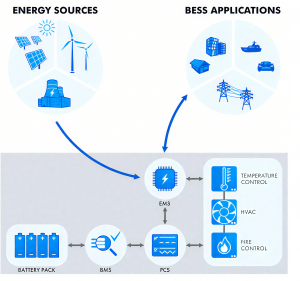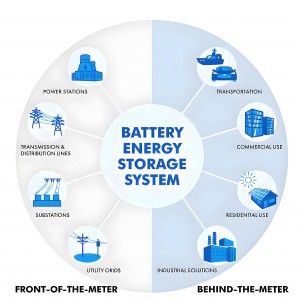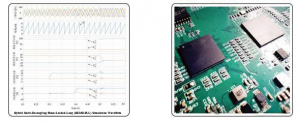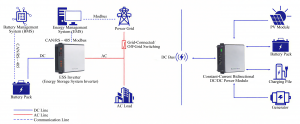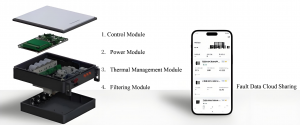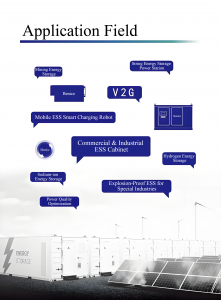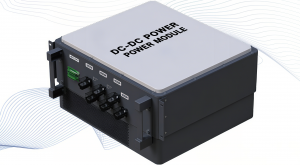Benice | June 13, 2025, 12:00 | Huizhou
A Battery Energy Storage System (BESS) is a complex solution that utilizes rechargeable batteries to store energy for later use. The type of BESS is related to its electrochemistry or the batteries it employs; such systems can use lithium-ion, lead-acid, nickel-cadmium, sodium-sulfur, and flow batteries.
To understand BESS and how it works, let’s first examine its structure and core components:
Batteries
Electrical energy provided from different sources such as solar, wind, or power plants is converted into chemical energy during the battery charging process. The energy released during battery discharge can power homes, vehicles, commercial buildings, and the grid. Batteries consist of cells, which can be arranged to form battery modules, battery packs, and battery enclosures.
Battery Management System (BMS)
The BMS ensures the safe and correct operation of the batteries. Each type of battery has specific charging and discharging conditions. The BMS ensures the batteries remain within the required current, voltage, and temperature ranges. It monitors battery parameters and estimates their State of Charge (SOC) and State of Health (SOH), ensuring reliable and long-lasting battery performance.
Power Conversion System (PCS)
The BESS uses a Power Conversion System to convert direct current (DC) into alternating current (AC), and vice versa. When charging the batteries, AC flows in from the power source and is converted to DC. When discharging, DC is generated and then converted back into AC required for the BESS application.
Energy Management System (EMS)
The EMS is a control unit of the battery energy storage system. It manages the available power within the BESS, dictating when, why, and in what quantity power is accumulated or released. The EMS integrates the various components of the BESS and optimizes its overall performance.
Safety Systems
There can be a series of safety systems, each responsible for a specific task. For example, the HVAC system maintains the required temperature and humidity within the BESS. Fire protection systems can detect smoke and prevent fire incidents.
▲ Typical BESS Structure (Source: Integra Sources LLC)
What Can BESS Do?
Renewable Energy Integration
BESS enables the effective utilization of solar and wind energy at any time and in any weather. Rechargeable batteries can store excess energy generated by intermittent renewable sources. This energy can then be dispatched according to user demand.
Integrated with battery storage solutions, renewable energy can replace fossil fuels, providing affordable and clean energy for diverse applications. Renewable energy integration is widely used in:
|
Backup Power
BESS can provide power to homes, businesses, and other facilities, ensuring their continuous operation. This is crucial for medical institutions and other organizations providing health and safety-related services. Depending on the storage capacity, BESS can provide backup power for the required duration, even during severe grid failures.
Black Start
BESS can assist power plants and grids in quickly restoring power after an outage. Consumers can use battery energy storage systems instead of diesel generators; this is a lower-cost and more energy-efficient black start solution. BESS can operate independently of grid transmission lines and supply power for the required time (from minutes to hours).
Applications Best Suited for BESS
BESS relies on affordable technology; for example, the price of lithium-ion batteries has fallen by nearly 90% over the past 10 years and will decline further. Battery storage solutions offer a wide range of configurations, providing different storage capacities and sizes, making them suitable for many industries and applications. These applications can be divided into Front-of-the-Meter (FTM) applications, which are utility-scale systems (where consumed power is measured by a meter); and Behind-the-Meter (BTM) applications, which provide power for use on-site (where consumed power is not connected to the grid and thus not measured by a meter). Below is a list of FTM and BTM BESS applications:
Front-of-the-Meter (FTM) Applications
Battery energy storage systems can make significant contributions to the operation and maintenance of utility-scale facilities and equipment. BESS can provide reserve capacity and black start services, achieve voltage and frequency stability, and save costs by deferring maintenance. FTM BESS applications include:
|
Behind-the-Meter (BTM) Applications
BTM systems can supply power to consumers bypassing the grid. BESS, together with green energy, can sustainably support independent power systems or microgrids. Manufacturers can use battery storage to store backup power, avoiding production facility downtime. Companies and households can use BESS to significantly reduce electricity costs through energy time shifting. BTM battery energy storage systems can be used for the following purposes:
|
▲ BESS Applications (Source: Integra Sources LLC)
Designing a high-quality BESS requires a professional team proficient in battery technology, power electronics, embedded software, and hardware development. Planning and coordinating every stage of the product from design to certification and manufacturing is crucial. Hiring engineers with relevant expertise and experience helps build mature battery energy storage systems that meet customer expectations.
Product Selection Recommendation
Product Features
Stability
- Adopts a third-generation DSP+FPGA dual-core architecture, significantly improving operating frequency and instruction speed;
- Uses a hybrid multi-decoupling HCMD PLL algorithm to effectively extract the voltage and frequency of the grid fundamental component, enabling timely response to grid voltage disturbances, enhancing grid-connection stability and robustness;
- Employs a layered structural design, separating heat sources and the control system into layers, improving system thermal performance, lifespan, stability, and features IP65 dust and water resistance.
Safety
- Uses optical fiber drive technology, replacing electrical signals with optical signals, achieving optical-electrical high-voltage isolation for control and drive signals, making the control system more stable and safer;
- Efficient thermal management, with optional intelligent air cooling or liquid cooling. Intelligent air cooling uses heat pipes and refrigerant cooling technology; liquid cooling features a self-developed flow channel design for efficient heat transfer, improving power device heat dissipation efficiency. Ensures full power output, guaranteeing revenue benefits.
Scalability
- Supports expandable multi-stage modes, configuring suitable DC/DC and PCS modules according to application scenarios to enable reliable operation of multi-channel DC source and AC source common DC bus energy storage systems;
- Scalable high/low voltage and power; functional system modular design for rapid response to customized requirements at different voltage and power levels; supports parallel operation mode; expandable with multiple communication and control interfaces, supporting third-party external EMS devices.
Easy Maintenance
- Modular system structural design, core modules assembled independently, user terminal disassembly/repair in minutes, suitable for industrial and commercial energy storage/charging operation and maintenance scenarios, with low maintenance costs; component selection fully considers durability and lifespan, eschewing low-cost models, using high-power, high-performance long-life components such as IGBT module sets, film capacitors, laminated busbars;
- Fault data shared via cloud, technical service available online 7*12 hours.
EETRUE 60kW-300kW Bidirectional DC/DC Power Converter
Product Features
Flexible configuration, expandable multi-pole mode, can adopt common DC bus structure, supports 1000V high-voltage DC bus
DC/DC bidirectional energy flow, DC input side can adopt constant current mode, maximum current 300A
Efficient thermal management, using heat pipes and layered design
Wide input/output DC voltage range, compatible with 200Vdc-1000Vdc systems
Supports new energy storage batteries, PV modules, new energy vehicle (NEV) integration, configurable for NEV V2G (vehicle-to-grid), MPPT, mobile energy storage smart charging robot DC fast charging, etc.
Modular design, easier maintenance
Circuit Diagram
Post time: Jun-13-2025


